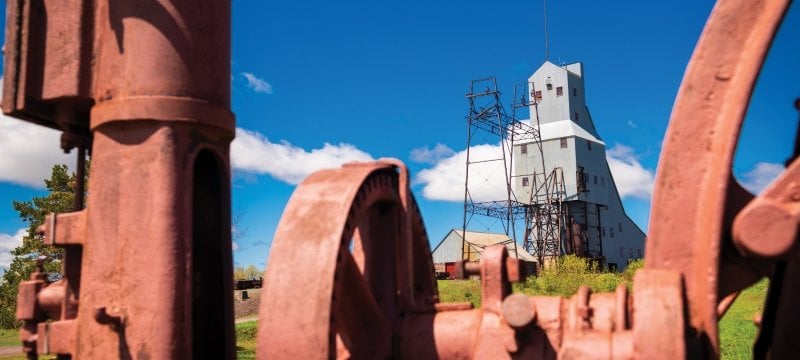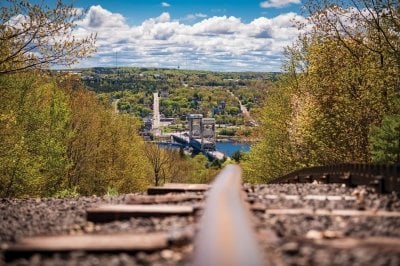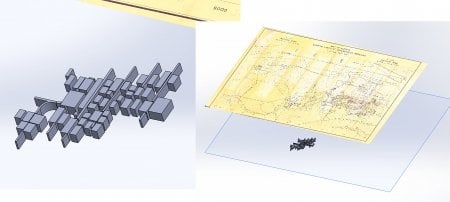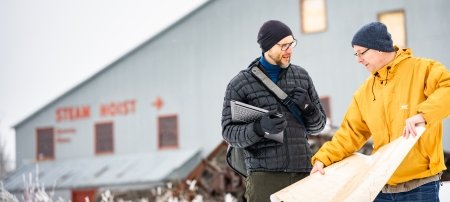Upper Peninsula mining established Michigan Tech—and the boom days' remains, from mine tailings to abandoned shafts, are sparking world-changing energy-transition breakthroughs at the University. One idea that's attracting national headlines and international collaboration? Using hydropower to store energy in old hard-metal mines.
Some people get their best ideas in the shower. Or while they're driving. Or working out. Energy policy expert Roman Sidortsov got one of his on an uphill run through an iconic Keweenaw copper mine site. His aha! moment came on Quincy Hill, home to Old Reliable, the mine nicknamed for the steady dividends it paid to investors from 1864 to 1920, and led to an initiative called PUSH: pumped underground storage hydropower.
"The idea popped into my head when I was running with my dog," Sidortsov said. "I was huffing and puffing on that steep, steep trail, and looking at the hoist and the railway track thinking, 'There's quite a bit of elevation there.' This idea came: How would you utilize this elevation, and how would you do that inside a mine? What would it look like?"
"This is a rare moment in time where communities can choose to leverage their liabilities as assets."
Sidortsov shared the idea with Michigan Tech colleagues, including fellow Department of Social Sciences faculty member Timothy Scarlett. He asked Scarlett, an expert in industrial heritage and archaeology who has studied the Keweenaw mining region for years, "Why doesn't anyone in the UP use hydropower?"
To put a twist on the adage, the rest isn't history. It's the story of how our past can power the future. Sidortsov assembled a research team of scientists and engineers who proved it's feasible to store energy in old hard-metal mines, transforming them into cost-effective, income-generating community resources. The initiative, developed by Michigan Tech's Keweenaw Energy Transition Lab (KETL), is a novel closed-loop underground system that provides an elegant solution to address the global energy crisis on several fronts, from affordability and environmental cleanup to cultural respect and energy justice for post-mining communities.
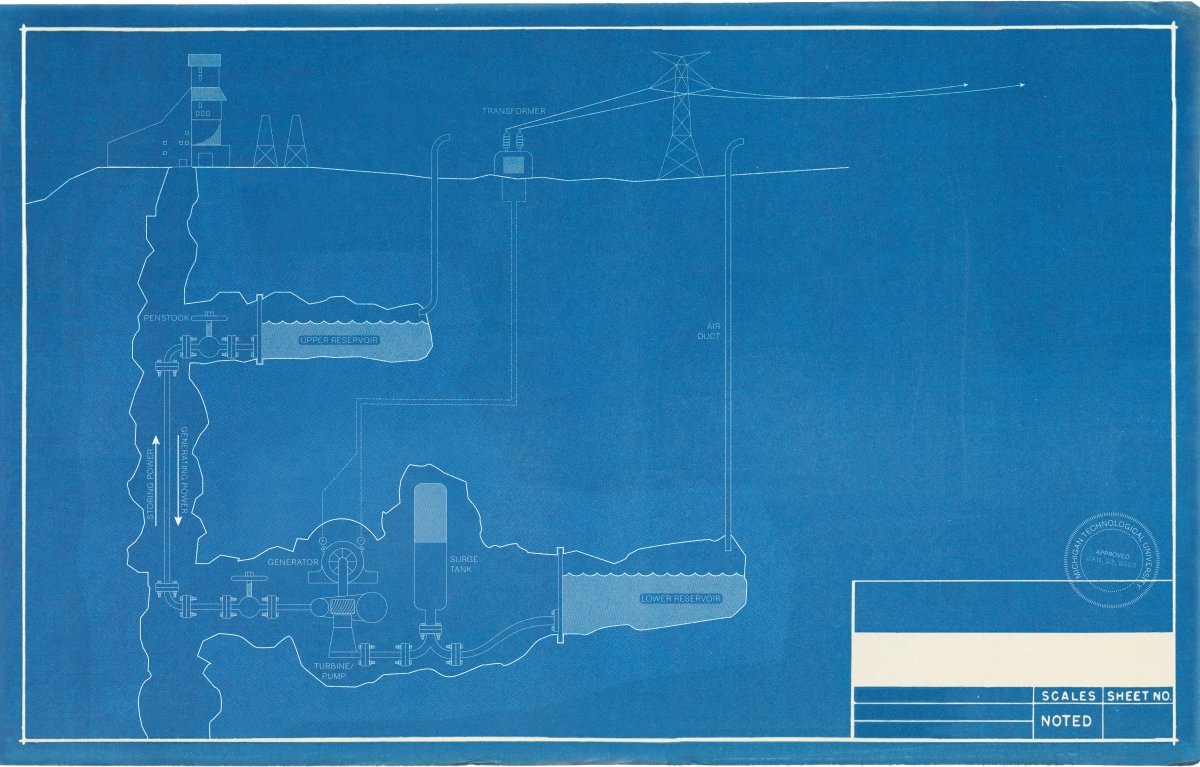
The idea is simple. The flow of moving water from a lower to a higher elevation is used to generate electricity by turning turbines. In pumped hydropower systems, water is pumped up into a reservoir during periods of low energy use. The stored energy is released through the turbine-generator system when demand goes up.
The technology is settled. Pumped storage hydropower has been used in the US since the 1930s. The US Department of Energy's (DOE's) Water Power Technologies Office (WPTO) reports that about 93 percent of the nation's utility-scale storage comes from our 43 pumped hydropower facilities.
The funding is available. In 2022, the US set aside $500 million for its Clean Energy Demonstration on Current and Former Mine Land Program to create new opportunities for clean, stable, community-based energy generation centers on old mining lands. The DOE has also released $28 million in funding to advance hydropower research and development as part of a $20 billion overall clean energy package through its newly formed Office of Clean Energy Demonstration.
New facilities haven't been built in decades due to environmental and aesthetic concerns and a stringent permitting process. Closed-loop pumped hydropower systems, like the design studied in PUSH, offer a solution that countries across the world are already embracing.
"The world is undergoing an energy transition. The transition is necessary so we can avoid a catastrophe—not just environmental. It's also social, political, and economic. It will have a profound impact on the global population, not just surviving but living well."
Repurposing disrupted landscapes to compensate for supply disruptions and the price volatility of natural gas is gaining ground globally. Subterranean post-industrial spaces offer a means to develop domestic energy storage. From the occupation of a nuclear energy plant to cutting off the flow of natural gas to Europe, the war in Ukraine is bringing into sharp focus the vulnerability of current systems. Distributed domestic systems that don't depend on a few critical international suppliers are more resilient. Among other projects raising awareness and providing solid feasibility data, Tech's PUSH group is currently collaborating with Mine Storage, a Swedish company conducting numerous pilot projects to repurpose old mines. Mine Storage plans to site the first closed-loop underground pumped hydropower system in Sweden.
Mountains to Climb in a Clean-energy Landscape
The resources and know-how are available. But the cultural buy-in, political will, and regulatory red tape are mountains harder to scale than Quincy Hill's 1,152-foot elevation. Much of the federal emphasis for funding clean energy projects thus far has been centered on coal-mining communities. The application cycle for the Clean Energy Demonstration Program on Current and Former Mine Land is slated to open this year and run through 2026. Hard-metal mining communities that decide to pursue projects will need to have the necessary community conversations and quickly figure out where they fit into selection criteria. And, when it comes to governmental approval and permit paperwork, patience is paramount.
Mine Power: The National Picture
-
17,750mine land sites in the United States, as estimated by the US Environmental Protection Agency
-
89 GWof capacity, according to the DOE (1 gigawatt powers roughly 750,000 homes)
-
93%of US utility-scale storage comes from the nation's 43 pumped hydropower facilities, according to the WPTO
-
100%of mine sites in the US screen positive for solar capacity, according to the DOE
Extracting Energy Solutions from Old Mines
Figuring out whether it's possible to sensibly and sustainably transform old mines into power storage centers requires a depth of knowledge deeper than Old Reliable's 6,225 feet. As if discerning the physical dimensions and condition of cavernous, often-flooded spaces isn't challenging enough, there are also historical, cultural, economic, and political aspects to contend with when considering each individual mine and its community.
Using Old Mines for Pumped Hydropower Energy Storage is a Game-changer
KETL wasn't able to conduct its PUSH feasibility research at Old Reliable due to lack of detailed data on community power consumption. Researchers turned east from the Copper Country to the Iron Range of Negaunee, Michigan, where they could work with WPPI Energy, a Wisconsin-based cooperative that has collaborated with MTU in the past. Negaunee City Manager Nate Heffron and City Planner David Nelson '09 shed light on the cultural importance of various mines, pointing researchers to the Mather B Mine for their study. Citizens at well-received public meetings helped fill in the historical context and offered insight on how people can come together to consider what energy projects will look like in their communities.
Funded by the Alfred P. Sloan Foundation, the PUSH case study determined that a hydro project at the Mather B, once built, would have the capacity to provide ultra-long-duration storage, enough to provide 30,000 people with continuous power for 3.5 months—at a profit. The study, which focused on hard-metal mines, used geospatial analysis to identify nearly 1,000 potential PUSH sites in the US.
Each project, Scarlett emphasized, will have unique characteristics, just as mine sites currently have their own individualized uses in the present day. For example, Negaunee High School is situated on Mather B property in former mine administration facilities. In the Keweenaw, Quincy Mine is a cooperating site of Keweenaw National Historical Park, offering guided tours complete with a tram ride down the hillside to Old Reliable's east adit where, inside, visitors can still view an MTU mining engineering classroom of yore.
Research Team Includes Alumni and Undergraduates
Transdisciplinary research is a Michigan Tech hallmark. The PUSH project would not have been innovative if it began with engineering or limited itself to the social sciences realm—although in the latter case, the department's combination of industrial archaeology, energy policy, and sociology proved particularly potent.
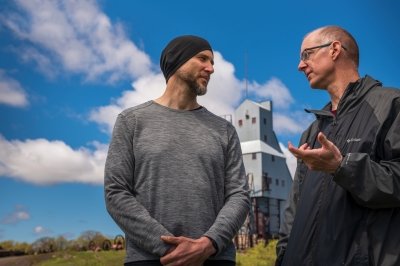
In keeping with its community-based research approach, KETL pulled together a diverse research team of faculty and students, including undergraduate members of the newly formed Alternative Energy Enterprise Pumped Hydro Team and 2021 Northern Michigan University graduate Hilde Eide of Norway. Students led by Trevor VanDyke '21 performed GIS mapping of load centers, evaluated economic feasibility, and conducted spatial analysis. Shaelyn Koleber '22 focused her senior capstone project on the PUSH water quality and treatment design. Jacob Chizek '23 built a 3D solid model of the Mather B. Hayden Augustyniak '23 completed an electrical design, and Alex Wilt '22 contributed to capital cost assessments. Like their fellow team members, Steven Sweet '23 and Emilia Fanelli '24 are focused on careers in renewable, alternative, or sustainable energy solutions. Their commitment was evident in the work they produced.
"The students' dedication and attention to details was awesome," said Sidortsov. "They all were instrumental."
In addition to Sidortsov and Scarlett, faculty researchers include fellow social sciences department member Chelsea Schelly, an associate professor of sociology; Ana Dyreson, assistant professor in mechanical engineering-engineering mechanics; Sarah Green, professor of chemistry; Timothy Eisele, associate professor of chemical engineering; David Watkins, distinguished professor of civil and environmental engineering; Stanley Vitton, professor emeritus of civil and environmental engineering and affiliated professor of geological and mining engineering and sciences; Qingli Dai, professor of civil and environmental engineering; and Chee-Wooi Ten, associate professor of electrical and computer engineering.
Other research team members who bring expertise to the project include energy market expert Joe Dancy '76 and University Archivist Lindsay Hiltunen. A senior lecturer of law and economics at Texas A&M University, Dancy has served on the board of directors for the student-run Applied Portfolio Management Program at Michigan Tech for more than 23 years. Hiltunen, a PhD student in the Department of Humanities, curates Tech's collection of primary documents on mining history and leads development of collections that define the historical context of community development, energy justice, and enhancing the voices of underserved communities.
Central to the research effort was Shardul Tiwari '22, a KETL fellow awarded his PhD in environmental and energy policy. Tiwari has worked around the world as an energy efficiency consultant, and specifically researched the social acceptance of a PUSH facility in the Upper Peninsula, along with evaluating the feasibility of participating in the Midcontinent Independent System Operator market.
PUSH Honors Heritage and Respects Communities
The bedrock of the project was feedback from those most affected by mine closures as well as some of the highest energy costs in the continental US: Upper Peninsula residents who call the region home and want it to remain a place where future generations can thrive.
Well before the final PUSH report was released, the research team's concept of converting mines into hydropowered batteries had captured the imagination of researchers, policy experts, and the general public—nowhere more so than in the Upper Peninsula, where mining heritage is a point of pride.
Michigan's Keweenaw Peninsula is known as the Copper Country for good reason. The remnants of the area's copper mining boom—which predates the western Gold Rush—are embedded in landscape and memory. Poor rock piles, abandoned shafts, smelter smokestacks, collapsing warehouses, and crumbling facades are prevalent in most of the small towns lining the Keweenaw Waterway, the main artery by which the so-called red gold was transported to world markets via Lake Superior. Some 14 billion pounds of copper were extracted from the Keweenaw, renowned as the most significant commercial deposit of native copper in the world. It is a legacy told in tell-tale tongues of sparkling black stampsand—and the profile of the Quincy Shafthouse No. 2, Old Reliable's profile jutting into the skyline as an enduring reminder of the region's national, historical, and personal significance.
"When mining communities go bust, the world moves on. These places matter to people. They are not wastelands. They are not abandoned," said Scarlett. He envisions old mine sites as centers for more than electricity. Beyond keeping the lights on, the showers hot, and the beer cold, these energy centers could empower communities to celebrate their legacy. It's a new way to think about energy beyond giant grids operated by energy corporations, independent systems operators (ISOs), or transmission companies.
Sidortsov said researchers heard time and again how beneficial it would be if mines were put to good use. "Different generations can be proud of what mines have done and would continue doing for the country and the world," he said.
PUSHing Forward Across the Nation and World
The PUSH report is a start. The raising of public awareness continues, an effort crucial to further exploring and expanding the initiative in concert with federal and global energy initiatives. PUSH was mentioned in an Associated Press article addressing the potential and pitfalls of hydropower. The report was linked in the Washington Post, and most recently in the Wall Street Journal, along with a slew of energy-focused journals and trade publications. Other press on the MTU-led initiative includes a piece by the Ludington Daily News, home to perhaps the most scenic pumped storage plant in the world on the shores of Lake Michigan. PUSH also garnered an interested audience at a recent DOE information-gathering workshop by its Office of Clean Energy Demonstration Programs, which centered on siting clean energy facilities on current and former mining lands.
Honor Mining Heritage, Solve the Energy Crisis, Stabilize Communities
Unlike some other energy-transition projects, neither know-how nor money are the main challenge facing PUSH projects. Mindset is top of the list. For example, society isn't used to the idea that there are alternatives to building more mines. Another relatively new concept: acknowledging that mines require cleanup and that remediation should be built into siting plans, rather than viewing contamination as an unintended consequence left for future generations to handle.
"Mining always leaves a legacy behind," said Tiwari, who presented on PUSH as a member of Michigan Tech's 2022 delegation to the United Nations Conference on Climate Change. "With a project like this, you're avoiding negative consequences like needing to mine for energy. You're avoiding creating legacies of contamination." He also noted that PUSH presents an opportunity to remediate damage already done. "Cleaning mine water is not novel," he said. "The process is there. It's more about bringing it into the system."
Like other PUSH team members, Tiwari said there's a need to keep the initiative's momentum going. "We should be doing multiple studies looking at multiple sites," he added.
What's Next for PUSH—and Post-mining Communities
"Mining communities around the world face similar challenges," said Scarlett. KETL researchers have joined 15 other universities from across the globe to expand what they've learned from PUSH within the JUSTNORTH project, designed to address a just and sustainable environment in the Arctic. They continue to reach out to community groups and others interested in learning more about PUSH. They want to connect with electric utilities, independent power producers, and transmission companies operating in Michigan to explore the potential for cooperation.
Wherever the community discussions take place—including here in Keweenaw—Scarlett is interested in facilitating the conversations and hearing what people have to say.
"Some people see the earth slowly reclaiming scars. Others see the sweat and toil of their ancestors. Some remember struggle and the loss of displacement, while others see refuge in 'God's Country.' Yet more have other visions for post-mining places," said Scarlett.
Some might even picture the day when Copper Country residents and visitors can turn their eyes to the weathered silver patina of night-lit Shafthouse No. 2 as it illuminates the skyline, knowing that Old Reliable is not only consuming energy, but producing it.
Michigan Technological University is an R1 public research university founded in 1885 in Houghton, and is home to nearly 7,500 students from more than 60 countries around the world. Consistently ranked among the best universities in the country for return on investment, Michigan's flagship technological university offers more than 185 undergraduate and graduate degree programs in science and technology, engineering, computing, forestry, business, health professions, humanities, mathematics, social sciences, and the arts. The rural campus is situated just miles from Lake Superior in Michigan's Upper Peninsula, offering year-round opportunities for outdoor adventure.
